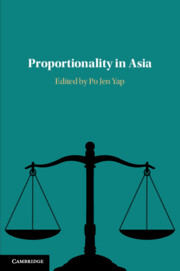Book contents
- Proportionality in Asia
- Proportionality in Asia
- Copyright page
- Contents
- Figures
- Tables
- Contributors
- Acknowledgments
- Abbreviations
- Introduction
- Part I Structured Proportionality
- Part II Anemic / Ad Hoc Proportionality
- Part III Doctrinal Equivalents of Proportionality
- Conclusion
- 11 Is There a Doctrine of Proportionality in Asia (or Anywhere)?
- Index
11 - Is There a Doctrine of Proportionality in Asia (or Anywhere)?
from Conclusion
Published online by Cambridge University Press: 18 September 2020
- Proportionality in Asia
- Proportionality in Asia
- Copyright page
- Contents
- Figures
- Tables
- Contributors
- Acknowledgments
- Abbreviations
- Introduction
- Part I Structured Proportionality
- Part II Anemic / Ad Hoc Proportionality
- Part III Doctrinal Equivalents of Proportionality
- Conclusion
- 11 Is There a Doctrine of Proportionality in Asia (or Anywhere)?
- Index
Summary
This Chapter questions whether there is a “doctrine” of proportionality. By “doctrine,” a way of dealing with problems across a range of problems. Using the country studies presented in this book, the chapter identifies a number of reasons for thinking that there is – and perhaps cannot be – such a doctrine. First, the components of proportionality are elements in any reasoned explanation for an outcome in a constitutional case; as a result, “hints” of proportionality analysis in cases not using its structured version may not in fact illustrate proportionality analysis at all. Second, courts allocate different analytic methods to different domains; as a result, proportionality analysis and categorical analysis co-exist in the system as a whole. Third, something like a categorical analysis is likely to appear at the “less restrictive alternatives” stage of proportionality analysis. Finally, even systems committed to proportionality analysis might find themselves eventually adopting some categorical rules as a means of achieving better results overall than proportionality would produce directly. The Chapter concludes with some observations about the role that structural, educational, and political contexts play in the choice between categorical and proportionality analysis.
Keywords
- Type
- Chapter
- Information
- Proportionality in Asia , pp. 269 - 283Publisher: Cambridge University PressPrint publication year: 2020



